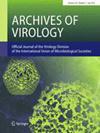Virus susceptibility of a new cell line derived from the muscle of koi (Cyprinus carpio koi)
Abstract
In this study, a continuous cell line (KM cells) derived from koi (Cyprinus carpio koi) muscle was established and characterized. The KM cells were subcultured for more than 70 passages and showed high viability after long-term cryopreservation. The KM cell line was optimally cultured in medium 199 containing 10% foetal bovine serum at 25°C. A chromosome analysis indicated that the cell line remained diploid, with a mean chromosome count of 100. DNA sequencing and comparative analysis of the 16S rRNA and cytochrome oxidase I gene sequences showed that the KM cell line originated from koi. In transfection experiments using the plasmid pEGFP, KM cells demonstrated a high level of transfection efficiency, suggesting their potential for use in foreign gene expression studies. Inoculation with spring viraemia of carp virus (SVCV) resulted in a substantial cytopathic effect, and the level of production of SVCV in KM cells was higher than that in the epithelioma papulosum cyprinid (EPC) cell line that is normally used to produce the virus. However, no cytopathic effect was observed when these cells were inoculated with koi herpesvirus, carp oedema virus, or grass carp reovirus. These observations suggest that the newly established KM cell line will be a valuable tool for investigating the pathogenesis of infection with spring viraemia of carp virus.


 求助内容:
求助内容: 应助结果提醒方式:
应助结果提醒方式:


